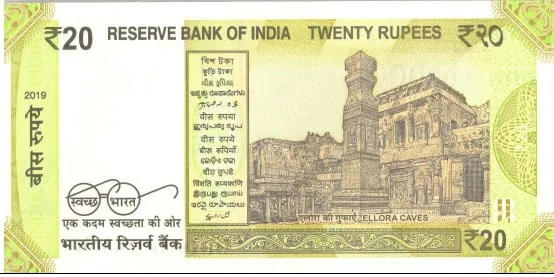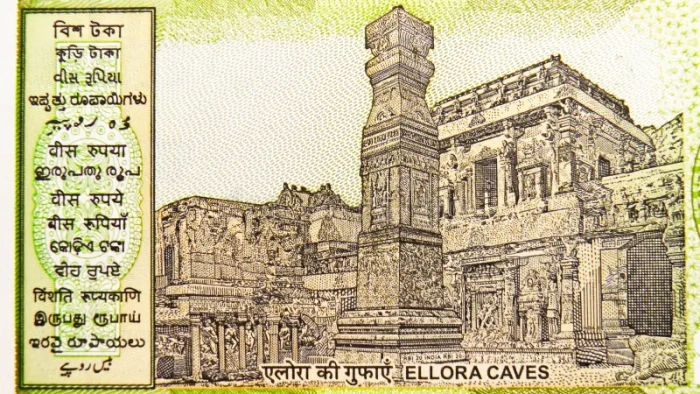Nestled amidst the magnificent Himalayas lies a divine relic that has captivated the hearts and minds of devotees for centuries. The Kailash Temple stands tall as a testament to the spiritual significance of Mount Kailash, believed to be the abode of Lord Shiva. But did you know that this iconic temple has found its way onto the currency of a nation?
In a remarkable move, the presence of the Kailash Temple on currency pays homage to its cultural and religious prominence. The intricate carvings and majestic architecture of this ancient marvel have been beautifully preserved on banknotes, serving as a constant reminder of the divine journey that lies within its walls.
For devotees and curious travelers alike, the inclusion of the Kailash Temple on currency offers a unique opportunity to connect with its mystical aura even from afar. It symbolizes the indomitable spiritual devotion of its people and showcases the profound impact of this sacred space on the collective consciousness.
As we delve into the divine journey of the Kailash Temple, we shall uncover the fascinating historical and cultural aspects that have made it a symbol of reverence and spirituality. Join us as we embark on a captivating exploration of this extraordinary temple and its significance in the fabric of our world.
Historical significance of the Kailash Temple
The Kailash Temple, nestled in the majestic Himalayas, is a testament to the rich tapestry of India's spiritual heritage. This awe-inspiring structure, carved out of a single piece of rock, dates back to the 8th century CE and is believed to be the earthly manifestation of Mount Kailash, the mythical abode of Lord Shiva.
The Kailash Temple's origins can be traced to the reign of the Pandava dynasty, when the Kshatriya ruler Ananta Varman commissioned its construction. This monumental undertaking was a reflection of the deep reverence and devotion the Pandavas held for Lord Shiva, the supreme deity in the Hindu pantheon. The temple's creation was a labor of love, with thousands of skilled artisans and craftsmen working tirelessly to carve the intricate reliefs and sculptures that adorn its walls.
Over the centuries, the Kailash Temple has witnessed the ebb and flow of history, weathering the storms of invasions, religious conflicts, and political upheavals. Yet, it has remained a steadfast symbol of the enduring spiritual resilience of the Indian subcontinent. Pilgrims and devotees from across the world have made the arduous journey to this sacred site, seeking to connect with the divine energy that permeates its very essence. The temple's ability to withstand the ravages of time and the unwavering devotion it has inspired are a testament to its enduring significance in the cultural and religious fabric of India.
Design and architecture of the Kailash Temple
The Kailash Temple is a true architectural marvel, a testament to the ingenuity and skill of its creators. Carved out of a single piece of rock, the temple's design is a masterful blend of Hindu and Buddhist influences, reflecting the syncretic nature of India's spiritual landscape.
The temple's most striking feature is its colossal scale, with the main shrine towering over 100 feet in height. The intricate carvings that adorn its walls and pillars depict scenes from Hindu mythology, including the cosmic dance of Lord Shiva, the creation of the universe, and the triumph of good over evil. These elaborate reliefs are a testament to the meticulous craftsmanship and attention to detail that went into the temple's construction.
The temple's layout is a reflection of the cosmic order, with the main shrine representing the axis mundi, the center of the universe. The surrounding structures, including smaller shrines, courtyards, and cloisters, are arranged in a symmetrical pattern that mirrors the celestial harmony. The use of dark basalt stone, which absorbs and reflects light in a mesmerizing way, adds to the temple's mystical ambiance, creating a sense of timelessness and transcendence.
Architectural scholars have long marveled at the Kailash Temple's innovative engineering, which allowed for the creation of such a massive structure entirely from a single piece of rock. The temple's construction is believed to have involved the use of sophisticated tools and techniques, including the use of water to carve the intricate details and the precise alignment of the structure with the cardinal directions. The Kailash Temple stands as a testament to the ingenuity and technical prowess of its creators, who were able to transform a raw, natural material into a masterpiece of sacred architecture.
Symbolism and religious importance of the Kailash Temple
The Kailash Temple is not merely a physical structure; it is a sacred space that embodies the profound spiritual and symbolic significance of Mount Kailash, the mythical abode of Lord Shiva. This iconic temple is revered as a microcosm of the cosmos, a physical representation of the divine realm where the ultimate reality, Brahman, is believed to reside.
At the heart of the Kailash Temple is the main shrine, which houses a lingam, a sacred symbol representing the formless, infinite nature of the divine. The lingam is believed to be a physical manifestation of Lord Shiva, the destroyer and transformer, who is central to the Hindu pantheon. The temple's intricate carvings and sculptures depict the various aspects of Shiva, from his role as the creator and preserver of the universe to his manifestation as the ascetic yogi, deeply immersed in meditation.
The temple's design also incorporates elements of Buddhist symbolism, reflecting the syncretic nature of India's spiritual traditions. The presence of stupas, or Buddhist reliquary monuments, within the temple complex, as well as the inclusion of Buddhist deities in the carvings, underscores the temple's role as a site of interfaith dialogue and harmony. This blending of Hindu and Buddhist influences is a testament to the inclusive and pluralistic nature of India's spiritual heritage.
For devotees, the Kailash Temple is a sacred space that facilitates a profound connection with the divine. The temple's towering presence, the intricate carvings, and the sense of timelessness that pervades the site all contribute to a transformative spiritual experience. Pilgrims who visit the Kailash Temple often report a deep sense of inner peace, a feeling of being in the presence of the divine, and a renewed commitment to their spiritual journey. The temple's enduring significance as a sacred site is a testament to its ability to inspire and uplift the human spirit.
The presence of the Kailash Temple on currency notes
The inclusion of the Kailash Temple on currency notes is a remarkable testament to its enduring cultural and spiritual significance. This iconic structure has been featured on the banknotes of several nations, including India, Nepal, and China, serving as a visual representation of the deep reverence and devotion it has inspired across the region.
The decision to feature the Kailash Temple on currency notes is a strategic move that highlights its importance as a cultural and religious landmark. By placing this sacred site on the very fabric of a nation's economy, the government acknowledges the temple's profound impact on the collective consciousness of its people. The intricate carvings and majestic architecture of the Kailash Temple have been meticulously reproduced on these banknotes, ensuring that the temple's essence is captured in all its splendor.
For devotees and travelers alike, the presence of the Kailash Temple on currency notes offers a unique opportunity to connect with its mystical aura even from afar. The sight of this sacred structure on a banknote can serve as a constant reminder of the divine journey that lies within its walls, inspiring a sense of reverence and wonder in the hearts of those who behold it. The temple's inclusion on currency also serves as a powerful symbol of national pride, showcasing the rich cultural heritage and spiritual legacy of the region to the world.
The decision to feature the Kailash Temple on currency notes is a testament to the temple's enduring legacy and its ability to transcend geographical and political boundaries. It is a recognition of the temple's role as a unifying force, a sacred space that brings together people of diverse faiths and backgrounds in a shared experience of the divine. The presence of the Kailash Temple on currency notes serves as a constant reminder of the power of spirituality to shape the cultural and economic fabric of a nation.

Cultural and spiritual impact of the Kailash Temple on currency
The presence of the Kailash Temple on currency notes has had a profound impact on the cultural and spiritual landscape of the regions where it is featured. By placing this sacred site at the heart of a nation's economy, the government acknowledges the temple's role as a unifying force, a symbol that transcends religious and political boundaries.
For many, the sight of the Kailash Temple on a banknote serves as a powerful reminder of the deep-rooted spiritual traditions that have shaped the identity of the region. The intricate carvings and majestic architecture of the temple, captured in exquisite detail on the currency, evoke a sense of wonder and reverence, inspiring devotees and curious travelers alike to embark on a spiritual journey to this sacred site.
The inclusion of the Kailash Temple on currency notes also serves to promote cultural exchange and interfaith dialogue. As the temple's image is circulated through the global economy, it becomes a visual ambassador for the region's rich spiritual heritage, fostering a greater understanding and appreciation of the diverse religious traditions that coexist in the area. This, in turn, can lead to increased tourism, cultural exchange, and a deeper engagement with the temple's profound spiritual significance.
Moreover, the presence of the Kailash Temple on currency notes has a profound impact on the collective psyche of the people. The temple's image becomes a constant reminder of the region's spiritual identity, a tangible representation of the divine that permeates every aspect of daily life. This can inspire a renewed sense of reverence and devotion, as well as a deeper connection to the temple's timeless legacy. The temple's inclusion on currency notes, therefore, serves as a powerful tool for the preservation and dissemination of the region's spiritual heritage.
Controversies and debates surrounding the Kailash Temple on currency
The presence of the Kailash Temple on currency notes has not been without its share of controversies and debates. While the temple's inclusion is widely celebrated as a testament to its cultural and spiritual significance, there have been some concerns and criticisms raised by various stakeholders.
One of the primary points of contention is the question of religious neutrality and the separation of church and state. Some argue that the featuring of a specific religious site on a nation's currency violates the principle of secularism, as it can be seen as a form of government endorsement of a particular faith. This debate has been particularly prominent in countries with diverse religious landscapes, where the inclusion of the Kailash Temple on currency notes may be perceived as favoring one religious tradition over others.
Another point of contention is the potential for the Kailash Temple's image to be used for political or nationalistic purposes. Critics have argued that the temple's presence on currency notes can be interpreted as a form of cultural appropriation, with governments using the temple's iconic status to further their own political agendas or to promote a particular nationalist narrative. This concern has been especially prevalent in regions where the temple's ownership or control has been a source of ongoing disputes between neighboring countries.
Furthermore, there have been concerns raised about the potential impact of the Kailash Temple's inclusion on currency notes on its long-term preservation and conservation. Some argue that the increased exposure and circulation of the temple's image could lead to a heightened risk of unauthorized reproductions, counterfeiting, or even physical damage to the original structure. This has prompted calls for stricter regulations and oversight to ensure the temple's enduring legacy is protected for future generations.
Despite these controversies, the presence of the Kailash Temple on currency notes remains a subject of ongoing debate and discussion. As with any cultural or religious symbol, its inclusion on a nation's currency is a complex issue that requires careful consideration of the various perspectives and concerns involved. Ultimately, the temple's enduring significance and its ability to inspire devotion and wonder continue to drive the conversation around its representation on the global economic stage.
Preservation and conservation efforts for the Kailash Temple
The Kailash Temple, with its rich history and profound spiritual significance, has long been the subject of extensive preservation and conservation efforts. As a UNESCO World Heritage Site, the temple has been the focus of both national and international initiatives aimed at safeguarding its architectural and cultural legacy for future generations.
One of the key challenges in preserving the Kailash Temple is the harsh environmental conditions it faces, including the extreme temperatures, heavy snowfall, and the risk of natural disasters common to the Himalayan region. To address these threats, various government agencies and heritage organizations have implemented a range of measures, including the use of advanced monitoring and conservation technologies, the development of comprehensive maintenance plans, and the deployment of skilled teams of conservators and restoration experts.
In addition to the physical preservation of the temple, there have also been concerted efforts to document and archive the rich cultural and historical information associated with the site. This includes the digitization of historical records, the creation of comprehensive databases, and the establishment of research centers dedicated to the study of the Kailash Temple's significance. These initiatives not only help to safeguard the temple's legacy but also facilitate a deeper understanding of its role in the broader cultural and spiritual landscape of the region.
Furthermore, the Kailash Temple's inclusion on currency notes has also played a crucial role in raising awareness and garnering support for its preservation. The widespread circulation of the temple's image has helped to generate a sense of global interest and investment in its long-term conservation. This, in turn, has led to increased funding and resources being directed towards the temple's upkeep, as well as the development of innovative strategies for its protection and maintenance.
The preservation and conservation efforts for the Kailash Temple are a testament to the unwavering commitment of the region's people to safeguarding their cultural heritage. By ensuring the temple's enduring legacy, these initiatives not only honor the profound spiritual significance of this sacred site but also contribute to the broader goal of preserving the rich diversity of the world's cultural treasures.
The Kailash Temple as a tourist attraction
The Kailash Temple, with its awe-inspiring architecture and profound spiritual significance, has long been a major draw for tourists and pilgrims from around the world. As a UNESCO World Heritage Site and a revered religious destination, the temple has become a focal point for those seeking to immerse themselves in the rich cultural and spiritual traditions of the Himalayan region.
For many visitors, the journey to the Kailash Temple is a transformative experience, a chance to connect with the divine energy that permeates the site. The temple's towering presence, the intricate carvings that adorn its walls, and the sense of timelessness that pervades the entire complex all contribute to a profound sense of awe and reverence. Pilgrims often report a deep spiritual awakening, a renewed commitment to their faith, and a profound sense of inner peace after visiting the Kailash Temple.
In addition to its religious significance, the Kailash Temple also offers a wealth of opportunities for cultural exploration and discovery. Visitors can delve into the temple's rich history, learning about the various dynasties and rulers who have left their mark on this sacred site. They can also engage with the local communities, immersing themselves in the vibrant traditions and customs that have been passed down for generations. The temple's inclusion on currency notes has further fueled this cultural exchange, as travelers from around the world seek to connect with the temple's iconic image and the stories it represents.
The Kailash Temple's status as a major tourist attraction has also had a significant impact on the local economy. The influx of visitors has led to the development of a thriving tourism industry, with the creation of new hotels, restaurants, and transportation services to cater to the needs of the growing number of visitors. This, in turn, has provided employment opportunities for the local population and has helped to preserve the region's traditional crafts and artisanal practices.
As the Kailash Temple continues to captivate the hearts and minds of travelers, its role as a cultural and spiritual touchstone will only grow stronger. The temple's enduring legacy, as reflected in its presence on currency notes, serves as a powerful testament to the enduring power of faith and the transformative potential of sacred spaces. For those who visit, the Kailash Temple offers a profound and unforgettable experience, one that transcends the boundaries of time and space.
Conclusion: The enduring legacy of the Kailash Temple on currency
The Kailash Temple's presence on currency notes is a testament to its enduring legacy as a cultural and spiritual icon. This awe-inspiring structure, carved out of a single piece of rock, has captivated the hearts and minds of devotees and travelers alike for centuries, and its inclusion on the very fabric of a nation's economy is a remarkable acknowledgment of its profound significance.
From its historical origins to its architectural brilliance and symbolic importance, the Kailash Temple has woven itself into the collective consciousness of the region, transcending religious and political boundaries. The temple's image on currency notes serves as a constant reminder of the deep reverence and devotion it has inspired, a visual representation of the divine journey that lies within its walls.
The cultural and spiritual impact of the Kailash Temple's presence on currency notes is far-reaching, fostering a deeper understanding and appreciation of the region's rich spiritual heritage. As the temple's image circulates through the global economy, it becomes a powerful ambassador for the inclusive and pluralistic nature of India's religious traditions, promoting interfaith dialogue and cultural exchange.
Despite the controversies and debates that have surrounded the temple's inclusion on currency notes, the Kailash Temple's enduring legacy remains undiminished. The ongoing efforts to preserve and conserve this sacred site, coupled with its status as a major tourist attraction, ensure that the temple's profound significance will continue to be celebrated and revered for generations to come.
As we reflect on the Kailash Temple's presence on currency notes, we are reminded of the enduring power of faith, the transformative potential of sacred spaces, and the ability of cultural and spiritual icons to transcend the boundaries of time and space. The Kailash Temple's legacy, etched onto the very fabric of a nation's economy, stands as a testament to the profound impact that a single, awe-inspiring structure can have on the collective consciousness of humanity.



